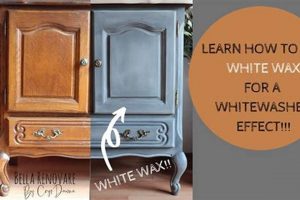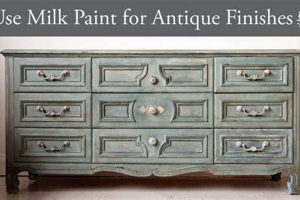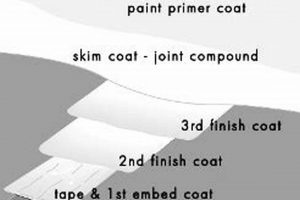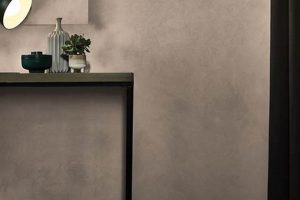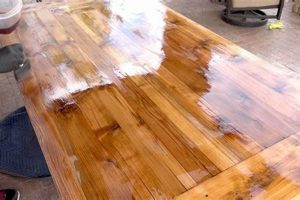The selection of a protective coating for kitchen cabinetry significantly impacts its appearance, durability, and ease of maintenance. Considerations range from matte to high-gloss options, each offering distinct aesthetic qualities and levels of resistance to wear and tear. For example, a matte finish provides a subtle, non-reflective surface, while a high-gloss finish delivers a sleek, modern look and is often easier to clean.
Choosing the appropriate coating contributes to the longevity and visual appeal of kitchen spaces. The coating selection influences the cabinet’s ability to withstand moisture, grease, and daily use. Historically, oil-based paints were prevalent; however, advancements in water-based acrylics and specialized enamels offer improved performance characteristics and environmental benefits.
Understanding the properties of different coatings is crucial when undertaking a kitchen renovation or refresh. This guide will explore various available coatings, their application methods, and their suitability for diverse kitchen styles and usage patterns, thereby empowering informed decision-making.
Coatings for Kitchen Cabinets
Achieving a professional and lasting result when coating kitchen cabinets requires careful planning and execution. The following tips outline critical steps for successful application, ensuring durability and aesthetic appeal.
Tip 1: Surface Preparation is Paramount. Prior to any coating application, thorough cleaning and sanding are essential. Remove all grease, dirt, and existing coatings to create a smooth, receptive surface. Improper preparation directly impacts adhesion and finish quality.
Tip 2: Primer Application is Crucial. Applying a high-quality primer specifically designed for cabinetry is necessary. Primer promotes adhesion, seals the substrate, and provides a uniform base for the topcoat, minimizing imperfections and enhancing color consistency.
Tip 3: Select the Appropriate Coating Type. Different coatings offer varying levels of durability, sheen, and ease of application. Consider factors such as water resistance, impact resistance, and cleanability when making a selection. Acrylic enamel is often preferred for its durability and low VOC content.
Tip 4: Apply Thin, Even Coats. Multiple thin coats are superior to a single thick coat. Thin coats allow for proper drying and prevent runs or drips. Employ a high-quality brush, roller, or sprayer to achieve an even, consistent layer.
Tip 5: Proper Drying Time is Essential. Adhere strictly to the manufacturer’s recommended drying times between coats and before handling. Insufficient drying can lead to tackiness, imperfections, and compromised durability.
Tip 6: Consider Environmental Conditions. Temperature and humidity can significantly impact coating performance. Avoid applying coatings in excessively hot, cold, or humid conditions, as these can affect drying time and finish quality.
Tip 7: Invest in Quality Application Tools. The use of high-quality brushes, rollers, or sprayers contributes significantly to the final result. Inexpensive tools often leave imperfections or uneven coating, compromising the overall finish.
Attention to these application considerations directly influences the longevity, aesthetic appeal, and overall performance of kitchen cabinet coatings. By following these guidelines, a professional-quality finish can be achieved.
The final section will discuss specific coating types and their suitability for various kitchen styles and functional requirements.
1. Durability
The longevity of kitchen cabinetry is directly proportional to the durability of the coating selected. The finish acts as a protective barrier against moisture, grease, impact, and daily wear. Coatings with poor durability are susceptible to chipping, scratching, and peeling, leading to aesthetic degradation and potential structural damage to the cabinet material. For instance, a lacquer finish, while offering a smooth appearance, may be less resistant to scratches compared to a catalyzed varnish. This difference in inherent resistance significantly impacts the long-term appearance and functional lifespan of the cabinetry. The selection of a durable finish is, therefore, not merely an aesthetic choice but a practical investment in the longevity of the kitchen.
The choice of coating material also influences resistance to specific environmental factors common in kitchens. Polyurethane finishes, known for their hardness and chemical resistance, offer superior protection against spills and cleaning agents. Acrylic latex paints, while more environmentally friendly, may require a protective clear coat to achieve comparable durability. Real-world examples include cabinets near stovetops, where heat resistance is paramount, or under-sink cabinets, where moisture resistance is crucial. Applying a finish with inadequate durability in these areas invariably leads to premature failure and costly repairs.
In conclusion, the durability of the finish is a fundamental aspect to consider when coating kitchen cabinets. Its influence extends beyond aesthetics, directly impacting the cabinet’s ability to withstand the rigors of daily use. A well-chosen, durable finish minimizes maintenance, preserves the cabinet’s appearance, and extends its functional lifespan. Ignoring this crucial aspect often results in compromised performance and increased long-term costs associated with repair or replacement. Prioritizing durability ensures a long-lasting and visually appealing kitchen environment.
2. Cleanability
The ease with which kitchen cabinets can be cleaned is a significant factor when selecting a coating. The finish dictates the surface’s susceptibility to staining, grease accumulation, and the adherence of food particles, directly impacting the maintenance required to preserve the cabinets’ appearance and hygiene.
- Surface Texture and Porosity
Porous surfaces, such as those with a matte finish, tend to trap dirt and grease, making them more difficult to clean. Conversely, smoother, non-porous surfaces, common in gloss or semi-gloss finishes, repel contaminants and allow for easier wiping. For example, a cabinet coated with a matte chalk paint requires specialized cleaning techniques to avoid damaging the finish, while a high-gloss enamel surface can typically be cleaned with a simple damp cloth.
- Resistance to Cleaning Agents
The coating must withstand repeated cleaning without degradation. Certain finishes are susceptible to damage from harsh chemicals, abrasive cleaners, or even prolonged exposure to water. A finish that dissolves or becomes discolored upon contact with common kitchen cleaners is unsuitable. For instance, a cabinet coating intended for light use would not be suitable in an area with heavy cooking.
- Stain Resistance
Kitchen cabinets are frequently exposed to staining agents, such as food spills, coffee splashes, and grease splatters. A finish with high stain resistance prevents these substances from penetrating the surface, facilitating effortless removal. A clear example is the difference between a painted cabinet with no topcoat, which readily absorbs stains, and one coated with a polyurethane sealant, which provides a barrier against staining.
The correlation between coating choice and cleanability is undeniable. Smooth, non-porous coatings with high resistance to stains and cleaning agents simplify kitchen maintenance, preserving the cabinets’ aesthetic appeal and hygiene. Conversely, finishes with poor stain resistance and susceptibility to damage from cleaning necessitate more frequent and intensive maintenance efforts, potentially leading to premature wear and tear. The selection of an appropriate coating necessitates a careful evaluation of the expected usage and cleaning protocols within the kitchen environment.
3. Sheen Level
The selection of sheen level is a critical consideration when determining what coating to apply to kitchen cabinetry. Sheen influences the perceived appearance, cleanability, and durability of the coated surface. Variations in sheen, ranging from matte to high gloss, offer distinct aesthetic qualities and performance characteristics.
- Matte Finishes
Matte coatings possess minimal reflectivity, resulting in a non-glossy, subtle appearance. While they effectively conceal imperfections in the underlying substrate, matte finishes tend to be more porous and, therefore, more challenging to clean. Matte coatings are suitable for kitchens where a subdued aesthetic is desired, and where the surfaces are not subjected to heavy staining or frequent cleaning.
- Eggshell and Satin Finishes
Eggshell and satin finishes offer a slight sheen, providing a balance between aesthetic appeal and practical functionality. They are more cleanable than matte finishes and offer improved resistance to staining. These finishes are versatile and suitable for a wide range of kitchen styles, offering a subtle luster that enhances the visual appeal without being overly reflective.
- Semi-Gloss Finishes
Semi-gloss coatings exhibit a moderate level of reflectivity, making them easier to clean than matte or satin finishes. Their durability and resistance to moisture make them a practical choice for kitchen environments. However, semi-gloss finishes tend to highlight imperfections in the underlying surface, requiring careful preparation prior to application.
- High-Gloss Finishes
High-gloss coatings possess the highest level of reflectivity, creating a sleek and modern aesthetic. They are exceptionally easy to clean and offer excellent resistance to staining and moisture. However, high-gloss finishes are unforgiving, accentuating any imperfections in the substrate. They are best suited for contemporary kitchens with meticulously prepared surfaces.
The appropriate sheen level for kitchen cabinets is contingent upon the desired aesthetic, the level of expected use, and the quality of the underlying surface. A careful evaluation of these factors is essential to ensure that the selected coating not only enhances the visual appeal of the kitchen but also provides adequate protection and ease of maintenance. Choosing a sheen level therefore contributes to the overall longetivity and visual success of any kitchen refurbishment.
4. Application Method
The method employed to apply a coating to kitchen cabinets is inextricably linked to the final appearance, durability, and overall quality of the finish. The chosen application technique must be compatible with the coating material and the desired outcome, influencing factors from surface texture to adhesion and uniformity.
- Spraying (HVLP, Airless)
Spraying, whether utilizing High Volume Low Pressure (HVLP) or airless systems, offers the potential for a smooth, even finish, particularly advantageous for achieving a flawless appearance with high-gloss coatings. This method minimizes brush strokes or roller stipple, crucial when surface imperfections are to be avoided. However, spraying requires meticulous preparation, including masking and ventilation, and often necessitates specialized equipment and expertise. For example, applying a lacquer finish via HVLP can yield a furniture-quality appearance, while improper airless spraying can result in excessive coating and runs.
- Brushing
Brushing is a more accessible application method, suitable for smaller projects or intricate details. The type of brush used significantly impacts the outcome; high-quality natural bristle brushes are often preferred for oil-based coatings, while synthetic brushes are better suited for water-based paints. Brushing can produce a textured finish, which may be desirable for certain aesthetic styles but can also lead to visible brush marks if not executed with care. Applying enamel paint with a low-quality brush might result in uneven coverage and trapped air bubbles, compromising the overall appearance.
- Rolling
Rolling offers a compromise between spraying and brushing, providing a relatively even coating over larger surfaces with less equipment than spraying. The nap of the roller is a critical consideration, with smoother naps ideal for achieving a less textured finish. Rolling can be an effective method for applying primer or base coats, but may not be ideal for achieving the highest level of smoothness required for some topcoats. Applying polyurethane with a high-nap roller can create an undesirable “orange peel” texture, diminishing the aesthetic quality of the finished cabinet.
- Combination Techniques
Employing a combination of application methods can optimize the final result. For instance, spraying may be used for the main cabinet surfaces to achieve a smooth finish, while brushing may be reserved for detailed areas or edges. Similarly, rolling can be used to apply a primer, followed by spraying for the topcoat. The effectiveness of combination techniques depends on careful planning and seamless integration of the different methods. A skilled craftsman might use a combination of brushing and “tipping off” (lightly dragging a brush across the surface) to eliminate roller stipple and achieve a near-sprayed finish.
The success of any kitchen cabinet coating project hinges on selecting the application method best suited to the specific coating being used, the desired finish, and the skill level of the applicator. Neglecting to consider the interplay between coating and application technique can lead to compromised aesthetic quality, reduced durability, and increased maintenance requirements. For example, applying high-gloss acrylic paint with a low-quality brush may lead to unsightly brushstrokes and an uneven finish.
5. Cost
The economic consideration is integral to determining what finish of paint is appropriate for kitchen cabinets. Material costs, labor expenses, and long-term maintenance expenses must be assessed when selecting a finish. Initial cost savings may be offset by increased maintenance or premature failure, making a comprehensive cost-benefit analysis essential.
- Material Expenses
Different coatings vary significantly in material cost. High-end lacquers and catalyzed varnishes typically command a higher price point than standard acrylic latex paints. The quantity of material required, influenced by coverage rate and number of coats, further impacts total expenses. For instance, a self-leveling acrylic enamel might require fewer coats than a traditional paint, potentially reducing overall material costs despite a higher per-gallon price.
- Labor Costs
Application complexity directly influences labor costs. Finishes requiring specialized equipment or multi-step application processes, such as spraying with HVLP systems, necessitate skilled labor and, consequently, higher expenses. Simpler application methods, like brushing or rolling, may be suitable for DIY projects or less skilled labor, potentially reducing costs but possibly compromising finish quality. Professional application of a conversion varnish, known for its durability, will invariably increase costs due to the specialized knowledge and equipment required.
- Preparation Costs
The degree of surface preparation needed prior to coating application affects overall costs. Finishes that require extensive sanding, priming, or repair work increase labor time and material consumption. For example, applying a high-gloss coating necessitates a perfectly smooth substrate, demanding more thorough preparation than a matte finish, thus escalating the overall project expense.
- Long-Term Maintenance and Repair Costs
While initial cost is a primary concern, long-term maintenance and repair expenses should be factored into the decision-making process. Durable finishes with high resistance to scratching, chipping, and staining minimize the need for frequent touch-ups or re-coating, resulting in lower lifetime costs. A cheaper, less durable paint might require reapplication within a few years, negating any initial savings and increasing overall expenditure.
A holistic approach to cost analysis is essential when selecting a coating for kitchen cabinets. Balancing initial material and labor expenses with the long-term implications of maintenance and durability provides a comprehensive understanding of the economic impact. Selecting a finish solely based on upfront savings may lead to increased expenditure over the cabinet’s lifespan, emphasizing the importance of a well-informed decision-making process.
6. Aesthetics
Aesthetics form an inextricable link with the coating applied to kitchen cabinets. The finish directly influences the visual character of the kitchen, impacting perceived style, brightness, and overall atmosphere. This aesthetic consideration extends beyond mere surface appearance; it encompasses the integration of the cabinets within the broader architectural context. For example, a high-gloss coating can create a modern and reflective surface, enhancing the perception of space within a compact kitchen. Conversely, a matte finish can contribute to a warmer, more traditional aesthetic, softening the lines of the cabinetry and blending seamlessly with rustic design elements. Therefore, the selection of a cabinet coating is not solely a matter of protection and durability but also a crucial design decision that shapes the kitchen’s visual identity.
The specific aesthetic goals of a kitchen design directly dictate the appropriate finish selection. A minimalist kitchen might benefit from a smooth, unadorned surface achieved with a satin or semi-gloss coating, emphasizing clean lines and functionality. In contrast, a country-style kitchen could incorporate a distressed or antique finish, achieved with specialized paints and techniques, to evoke a sense of history and character. The color of the coating further accentuates its aesthetic impact. Light colors, paired with a reflective finish, can maximize natural light within a space, while darker hues, combined with a matte finish, can create a sense of depth and sophistication. Ultimately, the successful integration of aesthetics into the cabinet coating selection relies on a cohesive vision that aligns with the overall design principles of the kitchen.
In summary, aesthetics constitute a primary driver in the selection process for coatings. The interplay between finish, color, and texture significantly affects the visual appeal and ambiance of the kitchen. While durability and cleanability remain critical functional requirements, the aesthetic impact of the coating choice should not be underestimated. A thoughtfully chosen finish can elevate the entire kitchen design, transforming a functional space into a visually appealing and harmonious environment. Challenges in balancing aesthetic desires with practical considerations often arise; however, careful planning and expert consultation can ensure that the final result achieves both aesthetic satisfaction and long-term performance.
Frequently Asked Questions
This section addresses common inquiries regarding the selection and application of coatings for kitchen cabinets, providing clarity on prevalent concerns and misconceptions.
Question 1: What is the most durable coating option for kitchen cabinets subjected to heavy use?
Catalyzed conversion varnishes and two-part epoxies offer exceptional durability, resisting scratches, chemicals, and moisture. These coatings are suitable for high-traffic kitchens where cabinets endure frequent handling and exposure to harsh conditions.
Question 2: Which coating type is most conducive to easy cleaning and maintenance?
Semi-gloss and high-gloss finishes, particularly those based on acrylic or polyurethane, possess smooth, non-porous surfaces that repel dirt and grease. These coatings facilitate effortless cleaning with common household cleaners.
Question 3: How does sheen level impact the perceived appearance of kitchen cabinets?
Matte finishes minimize reflectivity, concealing imperfections and creating a subdued aesthetic. High-gloss finishes, conversely, maximize reflectivity, imparting a modern and sleek appearance while highlighting any surface irregularities.
Question 4: Is spraying the superior method for applying coatings to kitchen cabinets?
Spraying, when executed correctly, yields a smooth, uniform finish, particularly with high-gloss coatings. However, proper surface preparation, ventilation, and equipment are essential. Brushing and rolling can produce acceptable results with appropriate techniques and materials.
Question 5: Can existing kitchen cabinets be successfully recoated, or is replacement necessary?
Provided the underlying cabinets are structurally sound, recoating is a viable option. Thorough cleaning, sanding, and priming are crucial to ensure proper adhesion and a professional finish.
Question 6: Are low-VOC (Volatile Organic Compound) coatings as durable and effective as traditional solvent-based options?
Advancements in water-based and low-VOC coating technology have significantly improved their performance characteristics. Many low-VOC options now offer comparable durability and resistance to traditional solvent-based coatings while minimizing environmental impact.
Selecting the appropriate coating requires a careful evaluation of durability, cleanability, sheen level, and application method, balancing aesthetic preferences with practical considerations.
The subsequent section will provide guidance on troubleshooting common problems encountered during the coating process and offering solutions to achieve professional-quality results.
Selection and application of “what finish of paint for kitchen cabinets”
Careful navigation of options when deciding what finish of paint for kitchen cabinets is paramount. The preceding exploration delineated essential considerations, encompassing durability, cleanability, sheen level, application method, and cost. Recognizing the nuanced interplay of these factors empowers informed decision-making, leading to optimized cabinet longevity and enhanced kitchen aesthetics. Improper evaluation can lead to suboptimal protection, increased maintenance, and compromised visual appeal.
The future of kitchen cabinet coatings anticipates continued advancements in material science, further bridging the gap between performance and environmental consciousness. As technology progresses, expect to see increasingly durable, sustainable, and aesthetically versatile coatings enter the market. Ultimately, the prudent selection of a coating will continue to be critical in the successful preservation and enhancement of kitchen cabinetry, underscoring its enduring significance.


